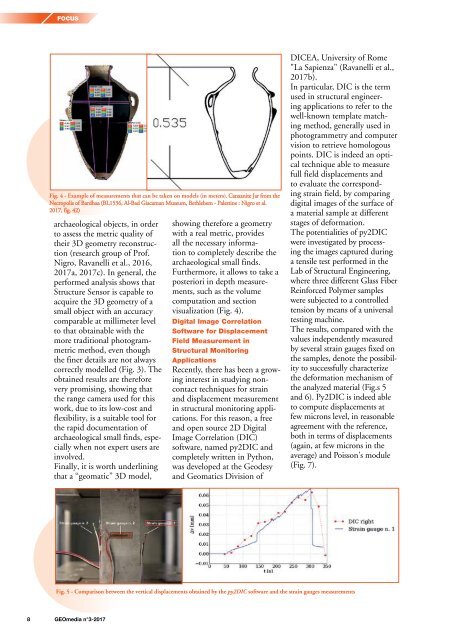GEOmedia 3 2017
You also want an ePaper? Increase the reach of your titles
YUMPU automatically turns print PDFs into web optimized ePapers that Google loves.
FOCUS<br />
Fig. 4 - Example of measurements that can be taken on models (in meters). Canaanite Jar from the<br />
Necropolis of Bardhaa (BL1536, Al-Bad Giacaman Museum, Bethlehem - Palestine : Nigro et al.<br />
<strong>2017</strong>, fig. 42)<br />
archaeological objects, in order<br />
to assess the metric quality of<br />
their 3D geometry reconstruction<br />
(research group of Prof.<br />
Nigro, Ravanelli et al., 2016,<br />
<strong>2017</strong>a, <strong>2017</strong>c). In general, the<br />
performed analysis shows that<br />
Structure Sensor is capable to<br />
acquire the 3D geometry of a<br />
small object with an accuracy<br />
comparable at millimeter level<br />
to that obtainable with the<br />
more traditional photogrammetric<br />
method, even though<br />
the finer details are not always<br />
correctly modelled (Fig. 3). The<br />
obtained results are therefore<br />
very promising, showing that<br />
the range camera used for this<br />
work, due to its low-cost and<br />
flexibility, is a suitable tool for<br />
the rapid documentation of<br />
archaeological small finds, especially<br />
when not expert users are<br />
involved.<br />
Finally, it is worth underlining<br />
that a “geomatic” 3D model,<br />
showing therefore a geometry<br />
with a real metric, provides<br />
all the necessary information<br />
to completely describe the<br />
archaeological small finds.<br />
Furthermore, it allows to take a<br />
posteriori in depth measurements,<br />
such as the volume<br />
computation and section<br />
visualization (Fig. 4).<br />
Digital Image Correlation<br />
Software for Displacement<br />
Field Measurement in<br />
Structural Monitoring<br />
Applications<br />
Recently, there has been a growing<br />
interest in studying noncontact<br />
techniques for strain<br />
and displacement measurement<br />
in structural monitoring applications.<br />
For this reason, a free<br />
and open source 2D Digital<br />
Image Correlation (DIC)<br />
software, named py2DIC and<br />
completely written in Python,<br />
was developed at the Geodesy<br />
and Geomatics Division of<br />
DICEA, University of Rome<br />
"La Sapienza" (Ravanelli et al.,<br />
<strong>2017</strong>b).<br />
In particular, DIC is the term<br />
used in structural engineering<br />
applications to refer to the<br />
well-known template matching<br />
method, generally used in<br />
photogrammetry and computer<br />
vision to retrieve homologous<br />
points. DIC is indeed an optical<br />
technique able to measure<br />
full field displacements and<br />
to evaluate the corresponding<br />
strain field, by comparing<br />
digital images of the surface of<br />
a material sample at different<br />
stages of deformation.<br />
The potentialities of py2DIC<br />
were investigated by processing<br />
the images captured during<br />
a tensile test performed in the<br />
Lab of Structural Engineering,<br />
where three different Glass Fiber<br />
Reinforced Polymer samples<br />
were subjected to a controlled<br />
tension by means of a universal<br />
testing machine.<br />
The results, compared with the<br />
values independently measured<br />
by several strain gauges fixed on<br />
the samples, denote the possibility<br />
to successfully characterize<br />
the deformation mechanism of<br />
the analyzed material (Fig.s 5<br />
and 6). Py2DIC is indeed able<br />
to compute displacements at<br />
few microns level, in reasonable<br />
agreement with the reference,<br />
both in terms of displacements<br />
(again, at few microns in the<br />
average) and Poisson's module<br />
(Fig. 7).<br />
Fig. 5 - Comparison between the vertical displacements obtained by the py2DIC software and the strain gauges measurements<br />
8 <strong>GEOmedia</strong> n°3-<strong>2017</strong>


















